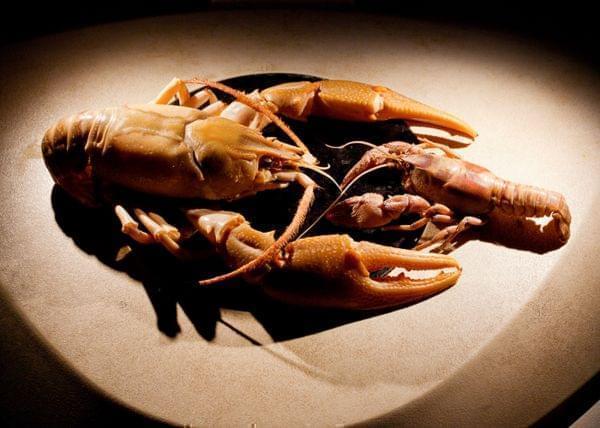Crustaceans the stars of this year’s Insect Fear Film Festival

Recently described Barbicambarus Simmonsii dwarfs the other crayfish is shares streams with. L. Brian Stauffer
On Saturday, February 22, 2020, the 37th Annual Insect Fear Film Festival (IFFF) will take place in Foellinger Auditorium on the U of I campus. As part of the celebration, this weeks commentary is written and voiced by three graduate students from the Department of Entomology, Jonathan Tetlie, Rachel Skinner, and Scott Clem. The theme of this year’s festival is “Crustacean Fear Films.”
Jonathan
So, why are crustaceans the theme of a festival with “insect” in the name? You may have thought, correctly, that crustaceans are not insects. What many people don’t realize is that crustaceans are actually very close relatives of insects. In fact, insects are more closely related to crustaceans than they are to spiders, which people more commonly associate them with.
Crustaceans are a megadiverse group of arthropods that includes crabs, lobsters, shrimp, krill, barnacles, and many more, consisting of over 68,000 described species. These animals come in many different shapes and sizes, and they occupy both aquatic and terrestrial habitats. Giant Japanese spider crabs, for example, can grow up to 13 feet long and weigh 45 pounds!
Rachel
Crustaceans can also be very tiny: ostracods, for example, are adorable, nearly microscopic filter-feeders that resemble miniature clams. You may not have realized it, but crustaceans can even be found in your own backyard. Woodlice, also known as pill bugs or roly polies are a type of crustacean known as an isopod, which are commonly found in rotting logs and decaying leaf litter throughout North America. Several types of aquatic crustaceans known as fairy shrimp and water fleas are active even at this time of year in temporary pools and other freshwater environments throughout Illinois.
Humans are most conspicuously linked to crustaceans as a food source. We annually consume over eight million tons of crustaceans or “shellfish,” accounting for more than $61 million in economic activity. Crustaceans also provide a multitude of ecosystem services, which are more difficult to quantify and often under-appreciated. Among other environmental benefits, crustaceans help maintain water quality, protect coastlines from storm surges and erosion, cycle nutrients, and provide habitat for a variety of other species.
Scott
In fact, several researchers associated with the University of Illinois are working to better understand and protect this diverse and important group. Chris Taylor of the Illinois Natural History Survey and his colleague Guenter Schuster of Eastern Kentucky University recently described a new species of crayfish, Barbicambarus simmonsi, from southern Tennessee—something that has not been done since 1884. What’s more, this new-to-science species is over twice the size of most other freshwater crayfish, truly a giant among them.
To learn more about crustaceans, and to meet some of them in person, stop by the Insect Fear Film Festival on February 22nd. Doors to Foellinger Auditorium open at 6pm for exhibits and activities, including exotic insect and crustacean displays from around the world, arthropod origami, face-painting, and arthropod art from local schools. In addition to the traditional insect petting zoo, this year’s festival will also feature live crustaceans including fairy shrimp, crayfish, blue and spider crabs, and roly polies. An introduction by Entomology department chair, May Berenbaum, will be given at 7:00, followed by a short anthology of crustacean-related films and the two feature films, Attack of the Crab Monsters and The Bay. Admission is FREE! For more information, search Insect Fear Film Festival.

